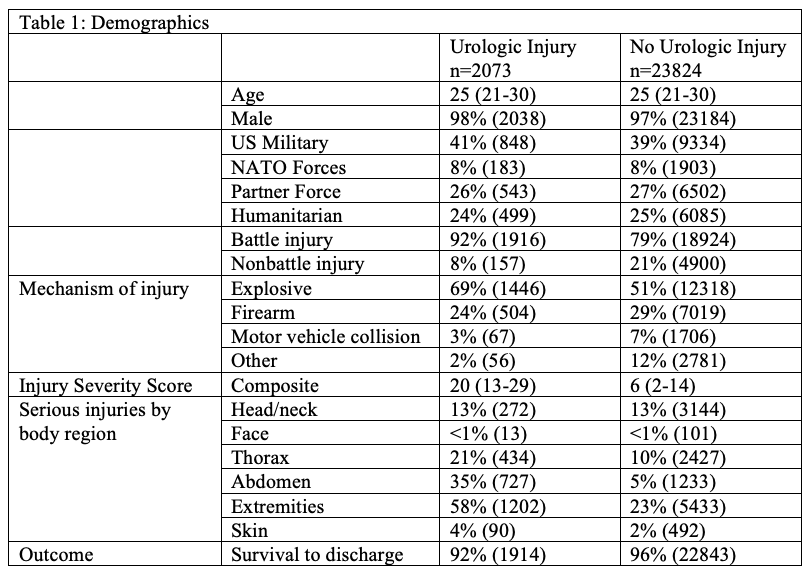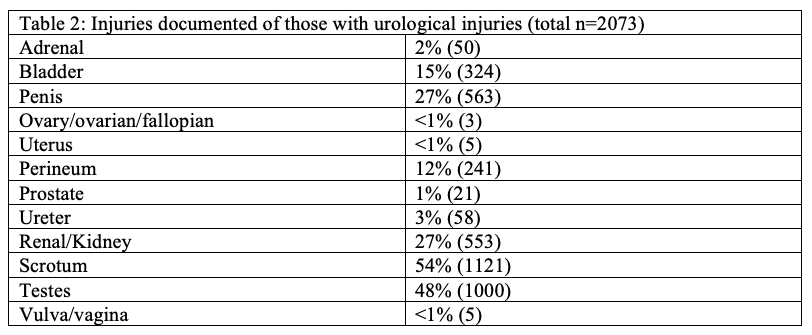Back
Poster, Podium & Video Sessions
Podium
PD29: Trauma/Reconstruction/Diversion: External Genitalia Reconstruction and Urotrauma (including transgender surgery) II
PD29-06: An Analysis of Combat-Related Urologic Injuries
Saturday, May 14, 2022
1:50 PM – 2:00 PM
Location: Room 244
Shane Kronstedt*, Piscataway, NJ, Andrew Fisher, Albuquerque , NM, Joseph Boyle, Piscataway, NJ, Daniel Grabo, Morgantown, WV, Michael April, Fort Carson, CO, Steven Schauer, San Antonio, TX
- SK
Podium Presenter(s)
Introduction: Genitourinary (GU) trauma is an underrepresented injury pattern of conflicts in the 21st century. GU injuries have previously occurred at a rate of 2-5% in pre-9/11 era military operations. In 2001-2013, GU injuries sustained during the conflicts of Iraq and Afghanistan occurred in approximately 13% of all combat casualties, as compared to 2-5% traditionally seen in previous wars or conflicts of the United States. Previous wars’ GU injuries were largely dominated by renal injuries, whereas now, we largely see complex combat wounding patterns suffered by the external genitalia. IEDs accounted for up to 89% of GU injuries during this timeframe. Until now, there has been little to no literature published on combat-related GU injuries beyond the year 2013. We sought to describe the incidence of combat-related genitourinary injuries and interventions from 01 January 2007 to 17 March 2020.
Methods: This is a secondary analysis of a previously described dataset from the Department of Defense Trauma Registry (DODTR). Within our dataset we used predefined search criteria to identify casualties with urological-based injuries and interventions to the kidneys, ureters, bladder, and reproductive organs.
Results: Within our dataset there were 25897 adult casualties. Within that, 8% sustained a urological injury. The median age was 25. US forces comprised the largest proportion (41%) with battle injuries predominating (92%). Explosive (69%) followed by firearm (29%). The median injury severity score was 20 (IQR 13-29). Most survived to hospital discharge (92%). The most frequently injured organs were the scrotum (54%), followed by the testes (48%), followed by the penis (27%) and kidneys (27%).
Conclusions: Explosives remain the leading cause of combat-related GU injuries in the modern era. The most common injury sites were the scrotum and testes. The most common genitourinary organ injured was the kidney. Our findings help inform pre-deployment training needs for surgeons.
Source of Funding: We received no funding for this study.


Methods: This is a secondary analysis of a previously described dataset from the Department of Defense Trauma Registry (DODTR). Within our dataset we used predefined search criteria to identify casualties with urological-based injuries and interventions to the kidneys, ureters, bladder, and reproductive organs.
Results: Within our dataset there were 25897 adult casualties. Within that, 8% sustained a urological injury. The median age was 25. US forces comprised the largest proportion (41%) with battle injuries predominating (92%). Explosive (69%) followed by firearm (29%). The median injury severity score was 20 (IQR 13-29). Most survived to hospital discharge (92%). The most frequently injured organs were the scrotum (54%), followed by the testes (48%), followed by the penis (27%) and kidneys (27%).
Conclusions: Explosives remain the leading cause of combat-related GU injuries in the modern era. The most common injury sites were the scrotum and testes. The most common genitourinary organ injured was the kidney. Our findings help inform pre-deployment training needs for surgeons.
Source of Funding: We received no funding for this study.



.jpg)
.jpg)